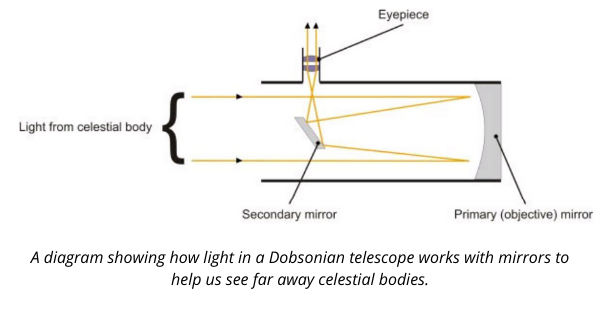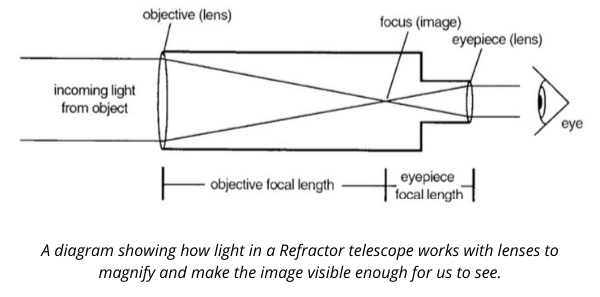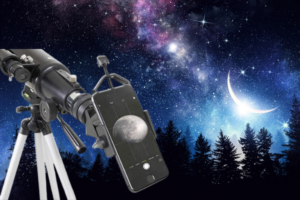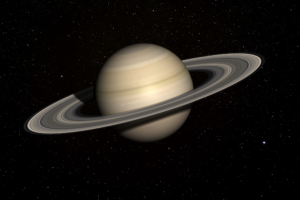Dobsonian Vs Refractor Telescope: Which Is Better?
Disclosure: This post contains affiliate links and I may earn a small commission (at no extra cost to you) if you click through and make a purchase. Thanks in advance – I really appreciate it!
As a beginner when I first became interested in stargazing, I thought all telescopes were the same. But after doing some research I found out that the Dobsonians and the refractors are the favorites among beginners.
While the Dobsonians are easy to use and produce a brighter image, refractors on the other hand are lightweight and require little to no maintenance.
So if you are confused between Dobsonian vs refractor telescopes and want to know the difference between them, then here’s the answer.
Key Takeaways:
Dobsonian vs Refractor
Dobsonian telescopes use mirrors to gather light and reflect it to a focal point to form an image. Refractor telescopes, on the other hand, use lenses to gather and focus light. Dobsonians are great for viewing deep-space objects whereas the APO refractors are best suited for astrophotography.
Dobsonians are a kind of reflector telescope and that’s why they use mirrors to gather and reflect light whereas the refractors use two lenses to bend or refract the light to form an image.
This is just the basic difference between the two, and if you want to learn more about them in terms of optical performance, usability, price, and more then go ahead and read this article till the end.
In this article, I will compare Dobsonian vs Refractor telescopes on 7 key differentiating factors, and I assure you that by the end of this article you will be in a better position to decide which one is best for you.
Basic Features: Dobsonian Vs Refractor
Below is a quick summary of the basic differences between the Dobsonian and refractor telescopes. Later in this article, we will discuss each of these points (and more) in much greater detail.
Dobsonian Telescope
- Uses mirrors
- Big aperture for observing deep-sky objects.
- No chromatic aberrations.
- Beginner-friendly.
- Lower cost compared to the refractor of the same size aperture.
- Captures a lot of light (light bucket).
- Stable Alt-az mount.
- Needs collimation.
Refractor Telescope
- Uses lenses.
- Impressive contrast and sharpness.
- Chromatic aberrations.
- Lightweight and transportable.
- Almost no maintenance.
- Good for astrophotography.
- Right-side up images.
- Don’t need collimation.
Before we go any further, I think it would be great for you to quickly learn how Dobsonian vs Refractor telescopes work.
This will greatly help you in making the right choice for yourself.
What is a Dobsonian Telescope?
A Dobsonian telescope is simplicity in itself, a simple set of optics on a simple mount.
The name of the Dobsonian telescope comes from its creator John Dobson, who in the 1960s combined the simple design of the Newtonian telescope with the Alt-Azimuth mount.
Due to its ease of use and relatively low cost, it has become one of the most common telescopes recommended for beginners or for those wanting a larger reflector for the power, but at a lower price.
How Do Dobsonian Telescopes Work?

A Dobsonian is a reflector-type telescope and so uses mirrors rather than lenses to capture and reflect light for that image of your sky view.
When you point a Dobsonian telescope at a celestial target, it collects light rays from that object through the aperture (the opening).
This light travels inside the telescope’s optical tube assembly and hits the parabolic mirror placed at the end of the tube.
The light then bounces off the primary mirror and is directed towards the flat secondary mirror. It bounces off the secondary mirror again and is sent to the focuser where you place your eyepiece.
The benefit of this type of optical arrangement is the telescope’s light-gathering ability. The more light a telescope’s mirrors can gather is directly proportional to the fainter objects you can see.
They are nicknamed “Light Buckets” because their wide opening makes their light-gathering capability one of the best on the market.
Dobsonian telescopes have a big advantage over telescopes with lenses such as refractors, as mirrors are a lot cheaper to make than lenses.
Plus Dobsonians can be a lot bigger as bigger mirrors can be manufactured at a lot lesser cost compared to the convex lenses used in refractors.
The Dobsonian telescopes use a simple basic manual mount that supports the optical tube and can be manually moved by hand in the Altitude (up/down) and Azimuth (left/right) axis.
Dobsonian mounts sit low to the ground, are made typically of wood or metal, and feature a wide base at the bottom.
The advantages of Dobsonian mounts are that they are very cheap and simple to make and are exceptionally stable.
The disadvantages are that they are relatively heavy and awkward to transport and like all alt-azimuth mounts, aren’t really suitable for tracking the motion of objects.
Best Dobsonian Telescopes
If you’re looking for a Dobsonian telescope, then I would highly recommend checking any one of these 3 Dobsonian models. They are perfect for beginners as well as intermediates.
| Image | Title | Best For | Price | Buy |
|---|---|---|---|---|
 Top Top | Orion 8944 SkyQuest XT6 | Best 6" | See on Amazon | |
 Top Top | Orion SkyQuest XT8 Plus | Best 8" | See on Amazon | |
 | Sky-Watcher Collapsible Dobsonian 10-inch | Best 10" | See on Amazon |
Product prices and availability are accurate as of the date/time indicated and are subject to change. Any price and availability information displayed on [relevant Amazon Site(s), as applicable] at the time of purchase will apply to the purchase of this product.
Prices pulled from the Amazon Product Advertising API on:How Do Refractor Telescopes Work?
A refractor is an optical telescope that uses a system of lenses to collect light and form an image.
The refractor, invented in the 17th century, is the earliest type of optical telescope.
And nowadays it is still one of the most popular telescope designs in the world, used by both beginning amateurs and professionals.

A refractor is made of a long optical tube with a convex glass lens at the main opening. The light enters the telescope through this lens, then exits the telescope through the eyepiece for viewing.
The large convex lens collects rays coming from the light source and makes them converge at the focal point or focus where the image is formed.
The eyepiece that is placed near the focal point magnifies that image.
Unfortunately, refractors suffer from achromatic aberrations due to the inability of a lens to bring all wavelengths of color to the same focal plane.
You can look for telescopes with compound lenses (different types of glass) to correct color aberrations. Doublets are less costly, but triplets are designed to eliminate this issue.
Refractors come in many varieties, and they can be optimized for a variety of usage scenarios including astrophotography, research, and visual astronomy.
For astrophotography, apochromatic refractors are said to be best as they overcome the need for an extra field corrector or space.
Now that we understand how each of these telescope designs works, let’s discuss the main objective of this article – How is a Dobsonian different from a Refractor telescope, and which one is best for you?
But before that, here are 3 refractors that are worth checking out.
Best Refractor Telescope
| Image | Title | Best For | Price | Buy |
|---|---|---|---|---|
 Top Top | Gskyer Telescope, 70mm | Best For Beginners | See on Amazon | |
 Top Top | Orion 9024 AstroView 90mm | Best For Intermediates | See on Amazon | |
 Top Top | Sky-Watcher EvoStar 80 APO Doublet Refractor | Best For Astrophotography | See on Amazon |
Product prices and availability are accurate as of the date/time indicated and are subject to change. Any price and availability information displayed on [relevant Amazon Site(s), as applicable] at the time of purchase will apply to the purchase of this product.
Prices pulled from the Amazon Product Advertising API on:Choosing Between a Dobsonian Vs Refractor Telescope: 7 Key Differences
Below is a table with a quick summary of the 7 key differences between Dobsonian and refractor telescopes. Make sure that you continue reading this article as I will explain each of these differences in greater detail in the following section.
| CATEGORY | WINNER | WHY? |
|---|---|---|
| 1. Optical performance | Both | You can get sharp & bright images with either - a high-quality achromatic/apochromatic refracting lens, or a Dobsonian with one or more true parabolic mirrors. |
| 2. Price | Dobsonians | Mirrors are less expensive for larger aperture sizes compared to lenses used in refractors. For smaller telescopes, refractors still offer good value. |
| 3. Maintenance & ease of use | Refractors | Dobsonians require more maintenance of their internal components. |
| 4. Size | Refractors | Refractors are smaller and lightweight while Dobsonians can be bulky sometimes. |
| 5. For Deep-Sky Objects | Dobsonians | Large aperture Dobsonians can be very useful in observing distant nebulae, galaxies & star clusters. |
| 6. Astrophotography | Refractors | The triplet APO refractors with a fast focal ratio are the best choice for astrophotography. |
| 7. Traveling & portability | Refractors | Refractors are generally smaller & lightweight and can be easily carried in a backpack. |
1. Optical performance (Winner: High-quality refractors and Dobsonians are equally good)
When it comes to a telescope’s optical performance and clarity of images produced – Both refractors and reflectors can offer stunning views, as long as they are manufactured with high-quality components.
Beware of the cheap low-quality refractors as they are made of a single lens and suffer from chromatic aberration.
Chromatic aberration happens when the glass lens elements in a refractor are unable to focus all the colors of light at the exact same position because the refractive index of glass varies with the wavelength of the light passing through it, resulting in color fringing.
The chromatic aberration can be prevented by high-quality lenses that are made of Extra-Low Dispersion (ED) glass to reduce or eliminate any optical aberration.
Refractor telescopes using ED lenses are called Apochromatic, and the terms doublet, triplet, and quadruplet refer to the number of ED lenses these telescopes use.
Summary: If you’re looking to get the sharpest and brightest possible images from your telescope, then either a high-quality Dobsonian or a high-quality refractor telescope can be a great choice for you. For refractors, consider getting an achromatic or apochromatic lens. For Dobsonian, look for true parabolic mirrors and high-quality engineering.
2. Price (Winner: Dobsonian….Larger sizes)
Large size Dobsonians are much cheaper than the same size refractors. This is because Dobsonians use mirrors and large mirrors are cheaper to manufacture than high-quality glass for large refracting lenses.
This is especially true as you get towards very large apertures and you are aiming for the highest quality optical performance. A very large “triplet” apochromatic refractor is exponentially more expensive than a same-size Dobsonian telescope.
The bigger the aperture, the more it gathers light, right? The more light-gathering ability the more you will be able to observe the fainter details.
You can buy a good-sized aperture in a Dobsonian for less than you would a refractor telescope.
Summary: If you’re on a budget and looking for a telescope with good aperture size, a Dobsonian would definitely offer more “bang for the buck”. However, if you’re on a budget and looking for a smaller telescope, you should still consider refractors a good value.
3. Maintenance & ease of use (Winner: Refractors)
Refractor telescopes are closed tubes and therefore do not get dust, and other elements. It is quite easy to maintain these telescopes.
The lens in a refractor telescope attaches securely to the optical tube, and it rarely moves enough to require adjustment. Additionally, there are no complex internal components that can come out of alignment.
Refracting telescopes are incredibly simple to use and maintain due to their design simplicity.
A refractor telescope offers apparent advantages if you value comfort and convenience and want to be able to whip out your telescope at any moment and use it in minutes.
With Dobsonian telescopes, however, this is not the case. Dobsonians are a little more difficult to work with, as they need regular collimation.
When you make fine adjustments to the alignments of the optical elements of a telescope, it’s called collimation.
Collimation can be time-consuming and distracting, especially when you bring out your telescope and all you want to do is start observing the night sky immediately.
Refractors are an excellent choice for beginners because they are always ready to use. Even for skilled users, though, a refractor may be appealing because of its simplicity and convenience.
Summary: Refractors are extremely easy to use, making them ideal even for complete beginners. Dobsonians normally need a little more upkeep and care.
4. Size (Winner: Refractors)
Dobsonians can get a bit large and heavy whereas refractors are generally quite compact.
Refractors are lightweight and small, ideal for grab-and-go observing on a simple alt-azimuth mount. They are also easy to use and require no optical alignment. Just aim, focus, and enjoy.
But I should also mention here that although refractors are light in weight and economical in smaller sizes, or even the go-to computerized models, refractors become bulkier and considerably more expensive than other telescopes types in large aperture sizes.
Summary: Refractors are smaller and much more compact than the Dobsonians in small aperture sizes.
5. For Deep-Sky Objects (Winner: Dobsonians)
We know that for stargazing – the bigger the aperture is the more light it will be able to capture and more clearly you can view the night sky objects.
When it comes to deep-sky observation telescopes, aperture definitely wins. The more aperture you have, the more light you can collect. The more light you collect, the fainter an object you can see.
For refractors, as the diameter of the aperture increases, the cost and bulk of the lens increases exponentially faster. For this reason, most amateur astronomers prefer Dobsonian or reflector telescopes for viewing deep-sky objects such as nebulae, galaxies, and star clusters.
In fact, when it comes to large aperture sizes, Dobsonians are pretty much the only game in town for the average amateur.
While they may not look like a telescope to the first-time buyer, virtually all amateur telescopes over 14 inches in aperture are Dobsonians because other optical designs become impractical in such large apertures.
Summary: Dobsonian telescopes are best for deep-sky viewing as they come in affordable large aperture sizes. A larger aperture means more light collection ability, which means you’ll be able to see fainter, more distant objects in the sky. Refractors of the same aperture size, however, can get seriously bulky and expensive.
6. Astrophotography (Winner: Refractors)
Although there are also some great Dobsonians for astrophotography, refractors have some key advantages.
This is because you don’t really need a large aperture size for astrophotography. Astrophotography calls for a fast telescope that has a low focal ratio (ideally f/6 or lower for astrophotography).
Also, for astrophotography, smaller telescopes are often preferable because they are lighter. And lighter telescopes require less costly mounting systems.
Summary: If you want to take beautiful pictures of the night sky then go for Apochromatic (APO) refractors as they are the best choice for astrophotography. You don’t need your telescope to have a large aperture, instead, you want something lightweight with high optical quality and a fast focal ratio.
7. Traveling & portability (Winner: Refractors)
If you’re looking for a grab-and-go lightweight telescope that you can carry along with you on your travels, then look no further than the small refractor telescopes.
There are plenty of fantastic small refractors available, designed with special lightweight tubes for traveling.
You’ll find them in a variety of sizes and configurations and most of them come with their own backpack so that they can be safely packed and carried along.
Summary: If you’re looking for a portable telescope then Refractors are the best option for you.
Dobsonian Telescope Pros & Cons
Pros
- Simple to use
- Price – cheaper than refractors of the same size
- No need to spend time on polar alignment
- Great for beginners and all ages
- You get the most aperture for the dollar
- Great for planetary observation
- Best for deep-sky viewing
- Brighter images produced
- No image distortion
Cons
- Larger in size & bulkier
- Harder to store
- Not suitable for astrophotography
- Need regular collimation
Refractor Telescope Pros & Cons
Pros
- Good contrast and sharpness
- Light and transportable
- Closed tube
- Maintenance and cleaning almost never needed
- No thermal degradation
- Low image distortion
- Right-side up images
- Beginner-friendly
- Best for astrophotography
Cons
- Chromatic aberrations
- Expensive at larger apertures
Are Dobsonians better than the Refractor telescopes?
Well in some respect they are. Dobsonians are better at gathering light as they usually come with larger apertures. Dobsonians also produce much brighter and sharper images of celestial objects and are better suited for deep-sky observations.
Dobsonians are also usually cheaper as they use mirrors instead of lenses. The larger the telescope, the cheaper it will be as compared to a refractor telescope as mirrors are much cheaper to manufacture.
Dobsonians are much more stable than refractors too as they use a heavy Alt-az mount.
Also, the Dobsonians are easy to use which makes them a great choice for beginners as well as professionals alike.
Are Refractors better than the Dobsonian telescopes?
Refractors have their own advantages over Dobsonian telescopes. Refractors almost never need collimation as they come in a closed tube design where both – the eyepiece and the primary convex lens are fixed permanently on both ends of the tube.
Refractors are also the best option for you if you are interested in astrophotography. APO or apochromatic refractors are preferred over any other telescope type by astrophotography professionals everywhere.
Since refractors are smaller and lightweight, they are an ideal choice for travelers, wanting something portable, and for children.
Conclusion
At the end of the day, it depends on what you intend to use your telescope for, your budget, and whether you can physically manage the scope (where will you store it or do you need to transport it.
Keep in mind that there is no single best telescope type. It’s a personal choice and both Dobsonians, as well as the Refractor telescopes, have their advantages and disadvantages.
Written by:

Kavya Joshi
My love affair with space began in a field in India at the age of 7, when I looked up at the Milky Way for the first time. Ever since, I have been attempting to cram in every fact about the Universe, I can find into my head.
ABOUT US
We are a team of active amateur astronomers, here to help you with all your astronomy and science related needs – this is anything, from reviewing the latest telescopes to be released to talking about gravity and neurons. The Big Bang Optics was started because of our love for astronomy and to help others like us find the best telescope and accessories.
LEGAL DISCLAIMER
The Big Bang Optics is a participant in the Amazon Services LLC Associates Program, an affiliate advertising program designed to provide a means for sites to earn advertising fees by advertising and linking to Amazon.com. The Big Bang Optics also participates in affiliate programs with Clickbank and other sites. The Big Bang Optics is compensated for referring traffic and business to these companies.




